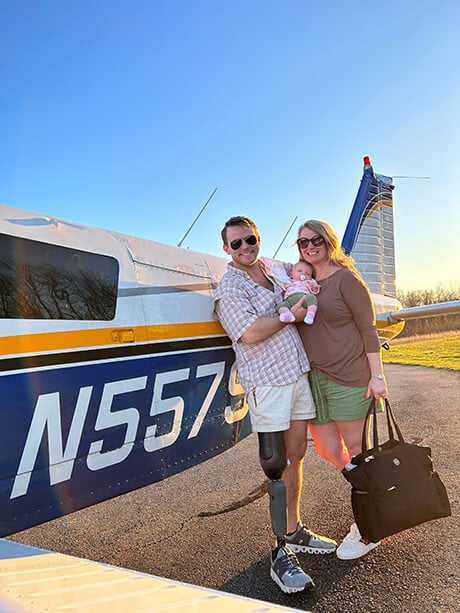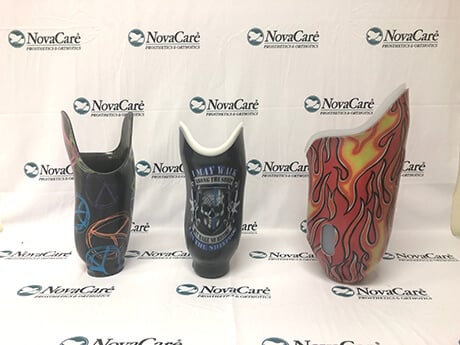Prosthetics
 Getting a prosthesis is a life-changing event, and NovaCare Prosthetics & Orthotics is here to support and educate you throughout the process.
Getting a prosthesis is a life-changing event, and NovaCare Prosthetics & Orthotics is here to support and educate you throughout the process.
A thorough evaluation is an essential first step in choosing the most appropriate prosthesis to meet your needs and achieve your goals.
We carefully balance functionality with aesthetics to provide you with the equipment that will support a more natural gait and/or improved motor skills. We then obtain an impression of your residual limb, create your custom device and fit it to your precise needs to ensure the prosthesis allows you to meet your full potential.
As your activity level, body or goals change, we help with adjustments that keep you active. We also partner with licensed physical and occupational therapists to design individualized treatment plans that include strengthening and balance activities, prosthetic gait training and fall prevention.
We are committed to providing you with the device that will best meet your needs and help you reach personal goals. We fit patients with a variety of lower and upper extremity prosthetics.
Lower extremity prosthetics
Whether you want to run a marathon or simply go for a walk, we can help. Our lower extremity program is built on experience and dedication. Our goal is to deliver designs that take you to the next level in function and comfort.
Types of lower extremity prostheses we offer:
- Above knee (Transfemoral)
- Below knee (Transtibial)
- Hip/pelvic
- Partial feet
We also fit prostheses for some of the more intricate and unique, specialized needs:
- Osseiointegration (OI) – A surgical procedure to insert a steel implant into the residual bone of the limb. A prosthesis can then be attached to that implanted piece. When used for a leg amputation, this procedure can enable the leg and hip bones to absorb weight bearing instead of the soft tissue left behind, so standing and walking feel more natural.
- Van Nes rotationplasty – A surgical procedure usually completed for bone cancer near the knee. A surgeon removes the middle part of the leg, including the tumor. The lower leg is reattached at the thigh, but rotated 180 degrees. The ankle joint now functions as the new knee joint. Rotationplasty is a more functional alternative to an above-the-knee full leg amputation
Upper extremity prosthetics
Upper extremity prosthetic limbs require innovative solutions. Whether you want to throw a baseball or simply do every day activities, we will partner with you to provide a customized upper extremity prosthesis that fits your needs and goals.
Types of upper extremity prostheses we offer:
- Above elbow (Transhumeral)
- Below elbow (Transradial)
- Forequarter (upper extremity and shoulder girdle)
- Partial fingers/hands
- Shoulder
Our upper extremity solutions provide the most advanced, functional and cosmetically pleasing devices available:
- Myoelectric-controlled prostheses are electrically powered rather than being controlled by your limb’s muscle strength. Myoelectrics are designed to mimic your motion. They use electrodes to pick up signals from the remaining muscles in your residual limb. These signals communicate various commands – for example, asking the elbow to flex and extend, the wrist to bend and rotate, and the hand to open or close. If muscle signals are not an option, additional inputs are available.
- Body-powered prostheses rely on the muscles of your body to power the prosthesis’ movements.
There are many options available for hands, wrists, elbows, arms and control mechanisms that offer comfort and an appealing design.
Sockets and suspensions
Socket fit and performance is the most important part of your prosthesis and has the best impact on success in rehabilitation.
A socket connects your residual limb to your prosthesis and should feel comfortable, stable and it should fit well. If the socket doesn’t fit properly, you may experience pain, sores, blisters, trips and falls and your prosthesis may feel heavy and awkward.

The socket remains in place on the limb. Suspension mechanisms are part of socket design and chosen prior to casting.
Suspension can be achieved through:
- Mechanical lock, which is a pin or lanyard attached at the end of a roll-on liner which engages into a lock in the socket.
- Suction suspensions, which include seal-in liners and direct skin contact. Air may be released via a pump or valve to achieve even adhesion.
- Anatomical suspension, which is achieved when the contours of the socket capture and hold onto the limb.
Our highly trained practitioners will discuss all options with you to ensure you receive the best fitting and functioning device for your unique needs.

